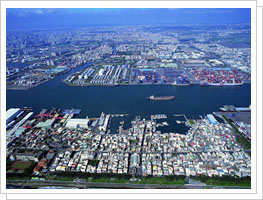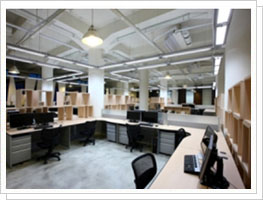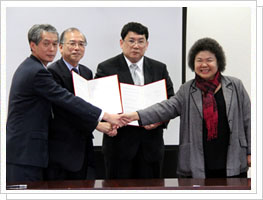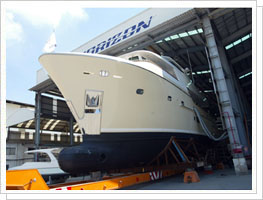| Kaohsiung's New Industrial Revolution – Competiveness UP |
Industry is the lifeblood of a city
Kaohsiung has evolved with the times
Creating a new and vibrant industry
Through pure energy and tenacity |
 |
Kaohsiung has long been a bastion for Taiwan's basic industries and the engine of growth for Taiwan's economy thanks to its air and sea links. The industrial character of Kaohsiung has also been defined by its large, stable workforce and emerging developments. A shift in the structure of domestic and foreign industries after 1981 saw the technology industry rise to the top. Since heavy industries such as petrochemical and steel made up the backbone of Kaohsiung's industry, the city entered a long period of transition. |
| To support the transformation of traditional industries and the development of emerging industries, the Kaohsiung City Government (KCG) launched the "Kaohsiung Commerce and Trade Park", port upgrades and Love River remedial program. Through these initiatives, the face of Kaohsiung's urban landscape gradually began to change. The commissioning of the Kaohsiung MRT also energized the tourism, media, cultural & creative industries. With the arrival of emerging software and green energy industries, the competitiveness of Kaohsiung City has experienced a resurgence along three main industry axes: the "Innovation Technology Corridor", the "Cultural and Creative Commerce and Trade District" and "Free Trade Logistics Center". |
| Investment Promotion UP – Creating a Investment Friendly Environment |
| Since the end of 2006, the KCG team under the leadership of Mayor Chen Chu has promoted the development of new industries. A mature investment environment has seen the low-carbon energy industry, software technology industry and cultural & creative industry continue to grow in value and output. Even more importantly, the new wave of emerging industries means that Kaohsiung will finally move away from heavy and high-emission industries to embrace low-carbon and high-technology industries instead. |
| Rise of the Green Energy Industry |
 |
The search for alternative energy sources has acquired new importance with countries around the world are faced with the threat of global warming. As Kaohsiung enjoys plenty of sunshine all year round, it is a natural candidate for the development of a local green energy industry and green economy. Solar power offers the city a major opportunity for industrial development in the 21st century and will hopefully see Kaohsiung become a key center for the solar power industry in Taiwan and the world. In March 2010, the KCG established the "SME Innovation Incubation Center for Green Industry" to assist traditional industries with upgrading and transformation. New investments and new factories are now on the way. |
| Elsewhere, the Kaohsiung County Government, the Kaohsiung City Government, the Export Processing Zone Administration and the Southern Taiwan Science Park Administration launched a joint investment promotion effort in the lead-up to the county/city amalgamation. To date, 57 key investment projects worth up to NT$116.1 billion have been secured, including many green energy industries. "Green Energy Technology" is investing NT$5.8 billion to expand its factory in the Southern Taiwan Science Park's Kaohsiung Campus while Taipower is planning to invest NT$1.6 billion in a solar power plant at the Yong-an salt flats. The new solar power plant will be the largest of its kind in Taiwan and will be completed by the end of May, 2011. Other key investments include ASE's K12 plant and new office building as well as COSTCO's new NT$1.2 billion North Kaohsiung store that will open in August this year. |
| Cultural & Creative + Software Technology Industries |
 |
Collaboration between the cultural & creative industry and software technology industry is now gradually becoming the driving force behind the development of emerging industries in Kaohsiung. In 2010, the KCG investment promotion delegations led by Mayor Chen Chu visited Japan and successfully persuaded Japanese companies such as Shogakukan and SONY to invest in Kaohsiung. Shogakukan has now moved into the Kaohsiung Software Technology Park while Sony Computer Entertainment Taiwan (SCET) has established a Digital Content Cooperative R&D Center in the Pier-2 Art Center. |
| SCET plans to jointly develop 20 online console games with Taiwanese companies within the next 3 years with an expected value of NT$1.8 billion. Not only have PS3 development kits, work stations, graphics and programming software been introduced from Japan, outstanding Taiwanese game designers have also been recruited to specialize in PS3 game development. These will not only promote a clustering effect among peripheral industries but enhance the international profile of Taiwan's culture and original content. |
 |
The Kaohsiung incubation team set up by SCET in partnership with E-Da has now developed a set of original games with market potential. The KCG Education Bureau also partnered with Shogakukan, Inventec and Mastodom to successfully bid for the Ministry of Economic Affairs' NT$120 million e-schoolbag program. In April 2011, 12 software companies in southern Taiwan including Foxconn subsidiary Dynamic Computing Technology formed the "Cloud Gaming Alliance" at the Kaohsiung Software Technology Park. The Alliance expects to produce over 100 games over the next 3 years with a total value in excess of NT$10 billion. |
| Etron Technology and the internationally renowned 3D animation company CGCG have also joined the Kaohsiung Software Technology Park to take advantage of Kaohsiung's software technology expertise. CGCG is collaborating with local schools to recruit 3D designers in southern Taiwan, and this will transform Kaohsiung into a key center for the development of 3D animation technologies. The KCG hopes to build on these investment promotion accomplishments so Greater Kaohsiung can become a smart city and Taiwan's first green industry demonstration district in the future. In March this year, Mayor Chen Chu visited Japan again to promote investment from the low-carbon and associated industries. During the visit, she toured the Kitakyushu Eco-Town material-recycle industry cluster center and signed a Memorandum of Understanding with the Kitakyushu Asian Center for Low Carbon Society. The experience and agreement will provide a reference for promoting industry transformation and the Greater Kaohsiung Environmental Park. |
| Industry Hinterland UP – The Three Key Industry Competitiveness Axes |
 |
The KCG had already drawn up the "Three Key Industry Competitiveness Axes" for Greater Kaohsiung's future industry strategy even before the county/city amalgamation. These from the north to the south were defined as the "Innovation Technology Corridor", "Cultural & Creative Commerce and Trade District" and "Free Trade Logistics Center". The "Innovation Technology Corridor" will extend from Lujhu and Gangshan through to the new Ciaotou downtown district. The Corridor will not only encompass the Kaohsiung Science Park, Benzhou Industrial Park and Kaohsiung Advanced Intelligent Science Park, but also 2,246 hectares of land from the Gangshan and Yong-an Industrial Parks will provide space for future expansion of the Kaohsiung Science Park. The KCG will construct an industry-university platform and introduce national research centers to develop the photonic, photovoltaic, bio-medical and metal processing industries. |
| Construction began on the Gangshan MRT station in July last year and in 2.5 years the new MRT station will connect the workforce of this industry corridor to the commuter network. The "Cultural and Creative Commerce and Trade District" is centered upon the Old Harbor district at Kaohsiung's No. 1 Harbor. An extension of the Kaohsiung MRT's cross-shaped network from the Qiaotou Sugar Factory, Zuoying Military Dependents Village and Pier 2 Art Center to Weiwuying and Da Dong Art Center will form a cultural & creative axis. The prime waterfront real estate from Pier 1 through to Pier 22 will see the completion of the Kaohsiung Exhibition and Convention Center, the Kaohsiung Maritime Cultural and Popular Music Center, and the Passenger Transport building between 2013 and 2015. These developments combined with the urban renewal project of Taiwan Railway's Kaohsiung Harbor Station should generate investments in the domestic tourism industry. |
| The "Free Trade Logistics Center" will be anchored by the No.2 Kaohsiung Harbor and then follow the No. 7 National Highway to link Linyuan, the new Dapingding downtown district and Renda Industrial Park. The brand advantage of "Made in Kaohsiung, Taiwan" will be leveraged to encourage foreign and local investors to set up brand headquarters in Kaohsiung and also be used to develop a yacht building district. The 113 ha "Yacht Industry District" has the strong support upstream and downstream industries with 23 companies signing expressions of interests. The City-Harbor Boulevard has also been completed to provide the No. 2 Harbor with an external transportation link. In the future, the district will be hone to yacht building, hardware, import/export, supply and logistics industries. |
 |
| As Kaohsiung already accounts for over 80% of these industries in Taiwan this will provide a strong foundation for future international expansion. Further expansion of the industry hinterland will be required to ensure that the three industry axes can realize their full potential. The KCG is currently planning to provide Greater Kaohsiung with a further 4,498 hectares of industrial land. Existing projects such as the Nanxing Project District, the Gangshan-Benzhou Expanded Industrial Park, International Container Terminal Phase 2, the Dafa Industrial Park's north side and the Fortune Institute of Technology's north side as well as new projects including the New Southern Taiwan Science Park Kaohsiung Campus and industrial land along No. 7 National Highway will serve to establish a foundation for long-term industrial development in Greater Kaohsiung. |
| Agriculture and Fishery Value-adding UP – The Agricultural Economy Advantage |
 |
The next step beyond industrial and commercial development is a return to the land. A return to the land does not mean a retreat to the past but rebuilding for the future. Greater Kaohsiung is one of Taiwan's major agricultural and fishery centers so is well posed for future developments in these industries. The "Doubling of Organic Agriculture Area", the "Farming and Fishing Village Revitalization Project", expansion of marketing channels, creation of production resume and certification marks, the planning of consumer logistics centers have all served to expand Greater Kaohsiung's existing economic advantage in the agricultural and fishery industries. |
| The KCG is currently focusing its efforts on boosting agricultural and fishery output in concert with the "One Township, One Product" scheme. Rural villages are now given customized assistance with upgrading their specialty agricultural products. Environmental upgrades such as the dredging of fishing village harbor channels and tourism market surroundings will gradually encourage the internationalization of Greater Kaohsiung's extensive agricultural and fishery resources to generate higher tangible profits for farmers and fishermen. |
 |
Mayor Chen Chu visited the Rakuten Group in 2008 to open up overseas markets for southern Taiwan's agricultural products through online marketing. After two years of effort, Rakuten Japan finally established its Taiwanese subsidiary Rakuten Taiwan. A branch office was also set up in Kaohsiung last year to identify specialty products in southern Taiwan as well as support training and business operations. The KCG Economic Development Bureau also used Rakuten and President Transnet's T-Cat delivery service to set up the "Kaohsiung Produce Center". This will be the largest online market for agricultural and fishery products in Taiwan and will help Greater Kaohsiung develop new markets for its agricultural produce. |
| For organic agriculture, not only has the KCG supported an increase in organic agricultural output but also helped organic farmers set up marketing channels. The launching of the "Breeze Market" in the square in front of Fongshan District's Women and Children Affairs Building provides organic agriculture with a fixed retail presence in Kaohsiung City. The Breeze Market has grown in scale and the range of produce over the years. In 2011, the new Hakka Cultural Park was added to the list of Breeze Market locations, increasing consumer confidence in the future of safe agriculture. |
Data source: Kaohsiung Pictorial 2011/05
翻譯資料來源(正體中文):來源 |
|